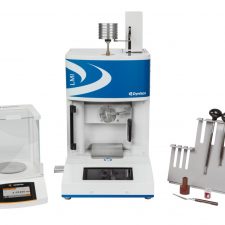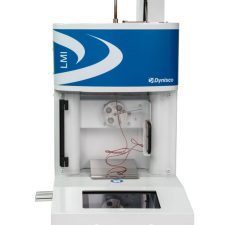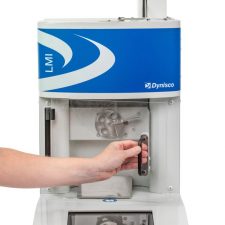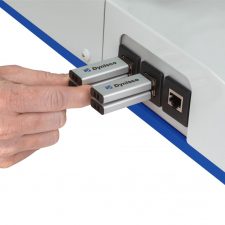LMI5500 Series
With an array of features and benefits ranging from ground-breaking accuracy to unified software between all laboratory and online production equipment, the LMI5500 is incredibly advanced and designed just for the thermoplastics resin industry. The LMI5500 brings a new level of ease of use with its removable inspection plate, increased access for sample cutting, and improved touch screen. It is capable of delivering a wide range of data for melt flow rate, shear stress, shear rate, apparent viscosity, instinsic viscosity, melt density, and testing conditions.
Dont forget- our LMI5500 is IoT enabled. The IoT native software of the LMI5500 allows for real-time access to your testing information.With the Dynisco Cloud Connect Subscription, you get comprehensive access of rheological data, correlations, and dashboards. This interface allows for a complete “Window into the Process” providing valuable insight to your polymer process.
- Gravitational correction
- New Windows 10 loT touch screen native interface
- Built in WIFI and ethernet
- HDMI and multiple USB ports
- Direct digital scale USB interface for sample weighing
- Performance meets international standards: ASTM D1238 & D3364, ISO 1133-1 & ISO 1133-2, BS2782, DIN 53735, JIS K7210
- Automatic sample cutter for ease and consistency in sample cutting
- Melt Flow Rate to Intrinsic Viscosity correlation for PET
- Nearly unlimited program storage capability
- Increased access to the die for sample cuttingwith a strategically placed mirror to easily view the die and cutting area
- Supports multiple languages
Certifications | Approvals
Collateral
From breakthrough technology in the industry’s most complete line of sensors to renowned quality and performance in indicators, controls, and analytical instruments Dynisco has demonstrated the skill, experience and know-how that not only deliver the right solution for your unique application, but also provide unparalleled customer support.
Datasheets
Podcasts
How Dynisco is Remolding the Plastics Industry Podcast
In this episode, Microsoft’s podcast hosts Deb Oberly and Dani Diaz talk with John Biagioni, President of Dynisco, who is bringing our vision of “rheology to the masses” to fruition with trailblazing cloud solutions for the plastics industry. Learn about the details of our industry and company, the surprises and insights of our journey crafting their IoT solutions, the immense value of the data we are collecting and our deliberate approach for continued success in this space.
Product Videos
ASTM/ISO Method A Test Using the Dynisco LMI5500 Melt Flow Indexer
Dynisco IoT Cloud Connect: There For You 24/7 When You Can’t Be
We are living in rapidly changing times. The entire world is working differently then we ever have in the history of manufacturing. Learn how the Dynisco IoT Cloud Connect can help processors manage and monitor their production lines remotely
Relevant Articles
Melt Flow Testing Article Part 1
Though often criticized, MFR is a very good gauge of the relative average molecular weight of the polymer. Since molecular weight (MW) is the driving force behind performance in polymers, it turns out to be a very useful number.
Melt Flow Testing Article Part 2
To fully appreciate the strengths and weaknesses of the melt-flow-rate (MFR) test it is important to know something about the way the test is performed.
Melt Flow Testing Article Part 3
There is a well-established relationship between something called the weight average molecular weight of a polymer and a parameter known as the zero-shear viscosity.
Melt Flow Testing Article Part 4
Few molders perform the test in-house. Of those that do, most don’t understand why they are doing it or what they are measuring.
Melt Flow Testing Article Part 5
There are two points in the manufacturing supply chain where a determination of average molecular weight (MW) is important. The first is when the material is first received by the molder. The second is after molding.
Melt Flow Testing Article Part 6
Once degradation has been established, the discussion inevitably turns to how it happened. It might be expected that the answer to this question is widely known. Not so. The good news is that the influences that cause polymer degradation during processing are few.
Melt Flow Testing Article Part 7
Here is why the melt flow test is not universal. As useful as the melt flow rate (MFR) test can be, it is not universally applicable. Fundamentally, the test is intended to document differences in molecular weight.
Melt Flow Testing Article Part 8
Here are the steps to take in cases where the MFR is not provided by the polymer supplier. The number of commercial materials that employ a melt flow rate (MFR) value as part of the published property profile attests tO the usefulness of the test.
Melt Flow Testing Article Part 9
Understanding the value of melt-volume rate. If you spend a lot of time looking at data sheets you have probably noticed a trend over the last several years in how the melt flow rate (MFR) is reported. Along with, or instead of, the MFR, a new line item is appearing called the melt volume rate (MVR).





